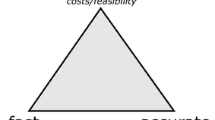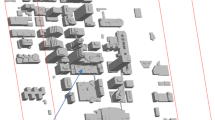Abstract
To model urban airflow and dispersion near buildings and in street canyons, several Gaussian diffusion models, and diagnostic urban models and methods based on computational fluid dynamics (CFD), are developed to provide a fast and adequate response when hazardous material is released. The ESTE CBRN software tool computes the urban atmospheric variables using the Reynolds-averaged Navier–Stokes equations with the k–ε closure model. The dispersion is modelled by an Eulerian model linked to the calculated flow field. The ESTE CBRN results are compared with the Joint Urban 2003 Street Canyon Experiment for the instantaneous puff releases conducted within the Urban Dispersion International Evaluation Exercise project. Urban airflow is simulated with a steady-state approach where the time-averaged velocity is evaluated from local measurements conducted outside downtown Oklahoma City, USA. Twenty anemometer measurements inside the downtown area are used to verify the CFD calculation, after which 22 individual puff releases are considered. The modelled velocity and sampler responses are in moderate agreement with the measurements. Many compared variables, such as the mean wind speed and puff arrival time, are generally well reproduced, and fulfil the urban modelling criteria. The turbulent kinetic energy is, in general, underestimated by 30–40%. The modelled time series of sampler responses fulfil many, but not all, of the urban criteria, mainly due to differences in puff trajectories and a lower dispersion intensity. Additionally, the impact of applying various three-dimensional meshes on the predicted sampler responses is tested.









Similar content being viewed by others
References
Allwine KJ, Flaherty JE (2006) Joint urban 2003: study overview and instrument locations. Tech Rep PNNL-15967, Pacific Northwest National Laboratory, Richland, Washington, DC
Briggs GA (1973) Diffusion estimation for small emissions. ATDL Contribution File No. 79, Atmospheric Turbulence and Diffusion Laboratory, Oak Ridge, Tennessee
Calhoun R, Gouveia F, Shinn J, Chan S, Stevens D, Lee R, Leone J (2004) Flow around a complex building: comparisons between experiments and a Reynolds-averaged Navier–Stokes approach. J Appl Meteorol 43:696–710
Chan ST, Leach MJ (2007) A validation of FEM3MP with Joint Urban 2003 data. J Appl Meteorol Climatol 46:2127–2146
Clawson KL, Carter RG, Lacroix DJ, Biltoft CA, Hukari NF, Johnson RC, Rich JD, Beard SA, Strong T (2005) Joint urban 2003 (JU03) SF6 atmospheric tracer field tests. NOAA Technical Memorandum OAR ARL-254, Air Resources Laboratory, Idaho Falls
Flaherty JE, Stock D, Lamb B (2007) computational fluid dynamic simulations of plume dispersion in urban Oklahoma City. J Appl Meteorol Climatol 46:2110–2126
Hanna SR, Chang J (2012) Acceptance criteria for urban dispersion model evaluation. Meteorol Atmos Phys 116:133–146
Hanna SR, Briggs GA, Hosker RP (1982) Handbook on Atmospheric Diffusion. Technical Report DOE-TIC-11223, Office of Energy Research, US Department of Energy
Hendricks EA, Diehl SR, Burrows DA, Keith R (2007) Evaluation of a fast-running urban dispersion modeling system using joint urban 2003 field data. J Appl Meteorol Climatol 46:2165–2179
Launder BE, Spalding DB (1974) The numerical computation of turbulent flows. Comput Methods Appl Mech Eng 3(2):269–275
Patankar SV, Spalding DB (1972) A calculation procedure for heat, mass and momentum transfer in three-dimensional parabolic flows. Int J Heat Mass Transf 15(10):1787–1806
Röckle R (1990) Bestimmung der stomungsverhaltnisse im Bereich Komplexer Bebauugsstruckturen. PhD thesis, Vom Fachbereich Mechanik, der Technischen Hochschule Darmstadt, Germany (in German)
Roe PL (1986) Characteristic-based schemes for the Euler equations. Annu Rev Fluid Mech 18:337–365
Wesson G, Katul G, Lai C-T (2001) Sensible heat flux estimation by flux variance and half-order time derivative methods. Water Resour Res 37:2333–2343
Wilson JD, Yee E, Ek N, d’Amours R (2009) Lagrangian simulation of wind transport in the urban environment. Q J R Meteorol Soc 135:1586–1602
Zhou Y, Hanna SR (2007) Along-wind dispersion of puffs released in a built-up urban area. Boundary-Layer Meteorol 125:469–486
Acknowledgements
We gratefully acknowledge the European Commission Directorate General for Migration and Home Affairs (DG HOME) for their support in the Urban Dispersion International Evaluation Exercise (UDINEE) activity. The authors wish to acknowledge the contribution of various groups to UDINEE. The datasets were prepared by the US Army Dugway Proving Group as manager of the JU 2003 database. Data from tracer-monitoring stations were provided by the National Oceanic and Atmospheric Administration (NOAA) Air Resources Laboratory Field Research Division. Data from the meteorological monitoring stations were provided by the Dugway Proving Ground. The Joint Research Center Ispra/Institute for Environment and Sustainability provided its ENSEMBLE system for model output harmonization, analysis and evaluation.
Author information
Authors and Affiliations
Corresponding author
Rights and permissions
About this article
Cite this article
Lipták, Ľ., Fojcíková, E. & Čarný, P. Comparison of the ESTE CBRN Model with the Joint Urban 2003 Experiment. Boundary-Layer Meteorol 171, 439–464 (2019). https://doi.org/10.1007/s10546-018-0393-z
Received:
Accepted:
Published:
Issue Date:
DOI: https://doi.org/10.1007/s10546-018-0393-z




